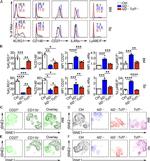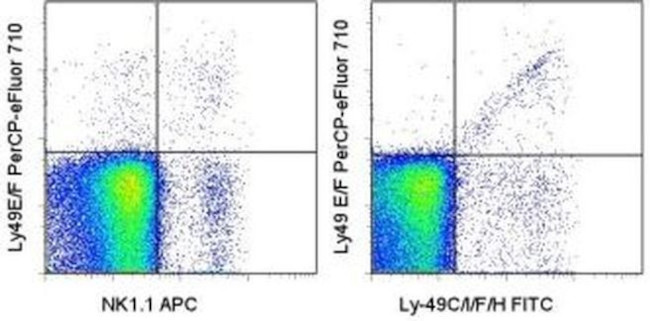Search Thermo Fisher Scientific
Invitrogen
Ly-49E/F Monoclonal Antibody (CM4), PerCP-eFluor™ 710, eBioscience™
FIGURE: 1 / 2
Ly-49E/F Antibody (46-5848-82) in Flow


Product Details
46-5848-82
Species Reactivity
Published species
Host/Isotype
Recommended Isotype Control
Class
Type
Clone
Conjugate
Excitation/Emission Max
Form
Concentration
Purification
Storage buffer
Contains
Storage conditions
Shipping conditions
RRID
Product Specific Information
Description: This CM4 monoclonal antibody reacts with a subset of mouse Ly49 receptors, specifically Ly49E and Ly49F. The Ly49 family of receptors are clustered in the Natural Killer Cell complex on chromosome 6. Expression is confined to NK cell, lymphocytes that play a key role in protection from infection and malignant diseases as well as graft rejection and autoimmune diseases. Ly49E is unique from other family members in that it contains an ITIM (immunoreceptor tyrosine-based inhibitory motif) domain and is expressed on all mouse strains. Developmentally Ly49E is one of the first markers detected on NK cells but expression decreases after birth to about 1% of NK cells in the adult spleen. Upon stimulation, expression can again be induced on Ly49E negative cells. The CM4 antibody is a useful reagent for the characterization of Ly49E expression when used in combination with other Ly49 antibodies such as 14B11 (Ly49C/I/F/H), 3D10 (Ly49C), YLI-90 (Ly49I), and A1 (Ly49A).
Applications Reported: This CM4 antibody has been reported for use in flow cytometric analysis.
Applications Tested: This CM4 antibody has been tested by flow cytometric analysis of mouse splenocytes. This can be used at less than or equal to 0.5 µg per test. A test is defined as the amount (µg) of antibody that will stain a cell sample in a final volume of 100 µL. Cell number should be determined empirically but can range from 10^5 to 10^8 cells/test. It is recommended that the antibody be carefully titrated for optimal performance in the assay of interest.
PerCP-eFluor® 710 can be used in place of PE-Cy5, PE-Cy5.5 or PerCP-Cy5.5. PerCP-eFluor® 710 emits at 710 nm and is excited with the blue laser (488 nm). Please make sure that your instrument is capable of detecting this fluorochrome. For a filter configuration, we recommend using the 685 LP dichroic mirror and 710/40 band pass filter, however the 695/40 band pass filter is an acceptable alternative.
Our testing indicates that PerCP-eFluor® 710 conjugated antibodies are stable when stained samples are exposed to freshly prepared 2% formaldehyde overnight at 4°C, but please evaluate for alternative fixation protocols.
Excitation: 488 nm; Emission: 710 nm; Laser: Blue Laser.
Filtration: 0.2 µm post-manufacturing filtered.
Target Information
The Ly49 family of receptors are clustered in the Natural Killer Cell complex on chromosome 6. Expression is confined to NK cell, lymphocytes that play a key role in protection from infection and malignant diseases as well as graft rejection and autoimmune diseases. Ly49E is unique from other family members in that it contains an ITIM (immunoreceptor tyrosine-based inhibitory motif) domain and is expressed on all mouse strains. Developmentally Ly49E is one of the first markers detected on NK cells but expression decreases after birth to about 1% of NK cells in the adult spleen. Upon stimulation, expression can again be induced on Ly49E negative cells. The CM4 antibody is a useful reagent for the characterization of Ly49E expression when used in combination with other Ly49 antibodies such as 14B11 (Ly49C/I/F/H), 3D10 (Ly49C), YLI-90 (Ly49I), and A1 (Ly49A).
For Research Use Only. Not for use in diagnostic procedures. Not for resale without express authorization.
How to use the Panel Builder
Watch the video to learn how to use the Invitrogen Flow Cytometry Panel Builder to build your next flow cytometry panel in 5 easy steps.
Bioinformatics
Protein Aliases: class I MHC receptor KLRA5; Killer cell lectin-like receptor 5; Killer cell lectin-like receptor 6; Ly-49e; Ly-49f; Ly49E receptor; Lymphocyte antigen 49e; Lymphocyte antigen 49f; T-cell surface glycoprotein Ly-49E; T-cell surface glycoprotein Ly-49F
Gene Aliases: Klra5; Klra6; Ly-49e; Ly-49f; Ly49-e; Ly49-f; Ly49e; Ly49F
UniProt ID: (Mouse) Q60652, (Mouse) Q60653
Entrez Gene ID: (Mouse) 16636, (Mouse) 16637

Performance Guarantee
If an Invitrogen™ antibody doesn't perform as described on our website or datasheet,we'll replace the product at no cost to you, or provide you with a credit for a future purchase.*
Learn more
We're here to help
Get expert recommendations for common problems or connect directly with an on staff expert for technical assistance related to applications, equipment and general product use.
Contact tech support

